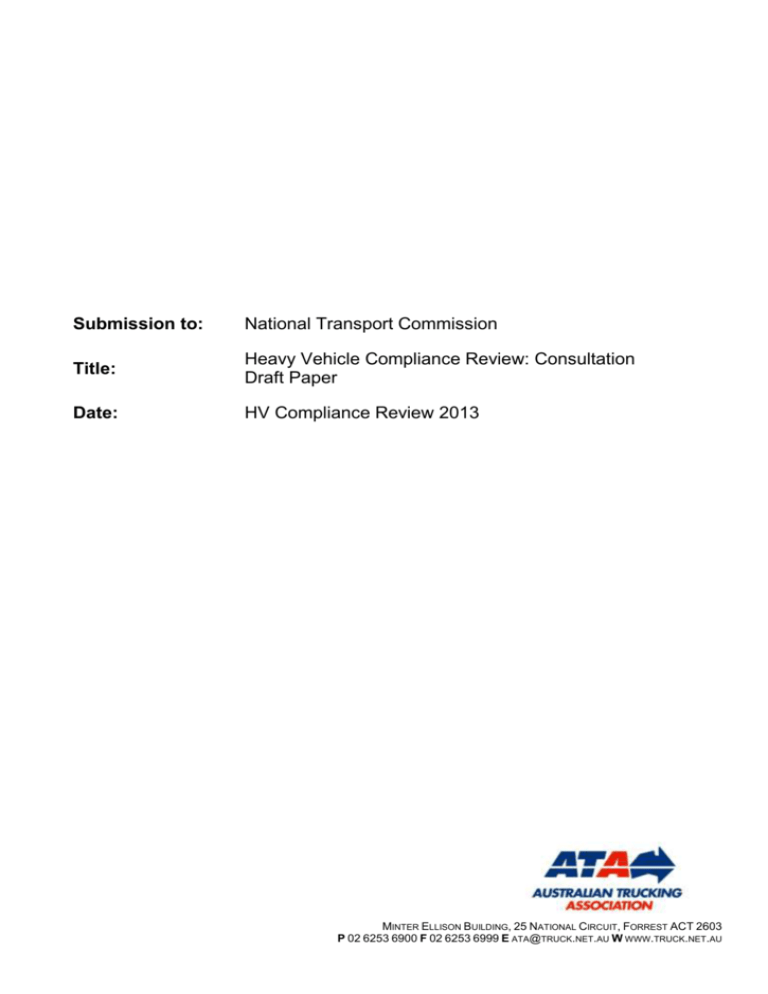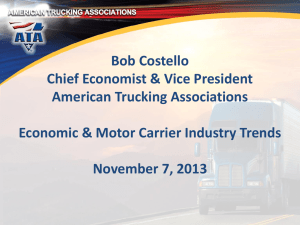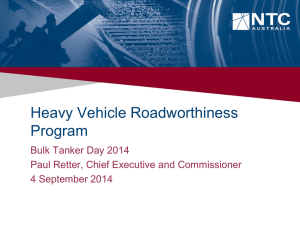Submission to NTC Heavy Vehicle Compliance Review
advertisement

Submission to: National Transport Commission Title: Heavy Vehicle Compliance Review: Consultation Draft Paper Date: HV Compliance Review 2013 MINTER ELLISON BUILDING, 25 NATIONAL CIRCUIT, FORREST ACT 2603 P 02 6253 6900 F 02 6253 6999 E ATA@TRUCK.NET.AU W WWW.TRUCK.NET.AU AUSTRALIAN TRUCKING ASSOCIATION Contents 1. Introduction ............................................................................................................................ 3 2. Australian Trucking Association .......................................................................................... 3 3. Recommendations ................................................................................................................. 3 4. Industry issues ...................................................................................................................... 4 4.1 TruckSafe® Heavy Vehicle Safety Accreditation Program ............................................. 4 4.2 A history of industry compliance.................................................................................... 5 4.3 Chain of responsibility and a ‘culture of compliance’ ................................................... 6 4.4 Infrastructure and regulatory compliance...................................................................... 7 5. Conclusion ................................................................................................................................ 8 ATA Submission on the NTC Heavy Vehicle Compliance Review Consultation Draft 2013. Page 2 AUSTRALIAN TRUCKING ASSOCIATION 1. Introduction As part of the National Transport Commission’s (NTC) Review of Heavy Vehicle Compliance, it released a draft consultation paper for public comment in September 2013. This submission is a response from the Australian Trucking Association (ATA) to the NTC’s invitation for industry submissions on the draft paper. 1.1 Review Objective The stated objectives of the NTC review are: To explore motivations for non-compliance as revealed by structured interviews with drivers, operators, peak bodies and enforcement officers; roadside observation and a review of the relevant literature. To analyse the powers to secure compliance contained within the HVNL; assess where and how they are currently used (and any limitations therein) and the extent to which they ‘capture’ and address the motivations for non compliance. Consider where and how the application of technology and meta-regulation may influence the compliance landscape. Map out the interdependencies in the various initiatives current within the compliance and enforcement space, including who is doing what. This includes the chain of responsibility (CoR) Review, Penalties Review, electronic work diary pilot, Five Star Trucking pilot and the compliance and enforcement (C&E) work packages being delivered by the NHVR. Make recommendations to promote compliance. In summary, the consultation draft for the NTC Heavy Vehicle Compliance Review is welcomed with some important caveats. ATA recommendations are listed in full in Part 3 below. For the purposes of the review, the ATA accepts the definition of “compliance”, which “is taken to mean behaviours that are consistent with the provisions of the relevant law” (page 5). The ATA does not accept the phrase “regulatory telematics” as meaningful to the trucking industry. Adoption of telematics to record compliance is merely the selection of a new (electronic) means of interception over traditional roadside and paperwork methods. Although potential applications pushed by such technologies have myriad implications for industry, the use of technology is not a regulatory end in itself. Much of industry is already using telematics devices because these are good for business and they help with compliance. If the policy aim is compliance and telematics aids drivers and operators to achieve it, then enforcement becomes a second order issue of priority by exception. Furthermore, “compliant” does not mean “safe”, so it remains primarily the type of compliance being demanded by the regulator rather than the specific tool it uses which is at issue in this review of heavy vehicle compliance. The baseline position remains that a heavy vehicle operator can be compliant and safe without telematics technology. 2. Australian Trucking Association The Australian Trucking Association (ATA) is the peak body that represents the trucking industry. Its members include state and sector-based trucking associations, some of the nation’s largest transport companies, and businesses with leading expertise in truck technology. 3. Recommendations Recommendation 1 That the NTC revise references to the TruckSafe® safety accreditation program to include an explanation and appraisal of both its methodology for ensuring safety and compliance and its demonstrated outcomes in comparison with other (possible) schemes. ATA Submission on the NTC Heavy Vehicle Compliance Review Consultation Draft 2013. Page 3 AUSTRALIAN TRUCKING ASSOCIATION Recommendation 2 The ATA recommends that the NTC continue to develop policies that simplify and improve the regulatory environment in order to maximise industry productivity. Recommendation 3 The ATA recommends, in consultation with industry, the establishment of a national ‘no blame’ investigation capacity for fatal truck crashes, similar to the current approach taken for aviation, marine and rail incidents. Recommendation 4 The ATA recommends that governments develop a nation-wide, publicly accessible database of coronial road safety recommendations, including updates and responses to recommendations and updates on recommendations that have not been followed up. Recommendation 5 The ATA recommends the bridge formula factor of two be reduced to reflect better compliance. 4. Industry issues 4.1 TruckSafe® Heavy Vehicle Safety Accreditation Program Much is made in Chapter 14: Gateway/Preventative Mechanism of a proposed Five Star licensing scheme for heavy vehicle operators (aka, a ‘safety rating scheme’) for which there are few details and no known case studies. On face value, this concept appears to present freight customers with additional material compounding the complexity of their decisions when selecting operators. Further, it undermines the COR policy as users will be encouraged to divert responsibility. At the same time, no detailed discussion is found in Chapter 14 of TruckSafe®, the long-standing industry safety accreditation program and its stringent requirements for heavy vehicle compliance. Such information is not found, for example, in section 4.3 – Alternative compliance, and thus the lack of detailed exploration is a major short-fall of the consultation draft. TruckSafe® is the trucking industry’s leading safety accreditation program. Its businesses meet higher safety standards than those required by law and are also audited regularly by qualified auditors selected by TruckSafe®. TruckSafe® is owned by the Australian Trucking Association but membership decisions are made by an independent body. A brief reference is made on page 95 to the TruckSafe® program as being ‘under consideration’ in the NTC forward work program. This section should be expanded to include more information about which particular elements will be placed under consideration, and for what practical result. Finally, none of the foreign non-government accreditation schemes nor most industry codes noted for general comparison with TruckSafe® operates in an environment of “Chain of Responsibility”. Most of these still focus principally on operators and drivers for compliance, rather than on other roles and responsibilities in the supply chain. TruckSafe® and the Australian Logistics Council’s National Logistic Safety Code are the notable exceptions that build on COR. Recommendation 1 That the NTC revise references to the TruckSafe® safety accreditation program to include an explanation and appraisal of both its methodology for ensuring safety and compliance and its demonstrated outcomes in comparison with other (possible) schemes. ATA Submission on the NTC Heavy Vehicle Compliance Review Consultation Draft 2013. Page 4 AUSTRALIAN TRUCKING ASSOCIATION 4.2 A history of industry compliance The NTC paper finds that compliance by the heavy vehicle industry over the past forty years is a “success story”, noting “changing consciousness about safety from the early 1970s when it was a peripheral concern to today where it is core business for many operators. Laws and policies introduced since the 1970s have significantly modified on-road behaviours and community norms. The success of the interventions is reflected in the statistics, which indicate a 36% fall in the number of fatalities involving large, heavy vehicles since 1990.” (page 20) The ATA welcomes the acknowledgement of a four decade trend in adherence to emerging road rules and safety standards, as well as industry’s very sound real-world safety outcomes. A longterm culture of compliant and safe behaviour is also evident in the statement that “Fatalities involving large, heavy vehicles in Australia are trending downwards, and industry members interviewed for this project expressed strong commitment to safety.” (page 5) Penalties, infringements and rules It is well understood by the NTC through its many consultations that industry finds maximum financial penalties imposed by courts under current road transport laws too high in most situations. Further, the ATA agrees with the NTC’s prediction “Any divergence between the police and transport offices may compromise consistency of enforcement and with it, the willingness of regulatees to comply.” (page 8). The ATA also notes the inequity of imposing administrative penalties (demerit schemes etc.) in situations when a court seeks not to impose any penalty. A major responsibility of lawmakers and associated regulators is not to make it difficult for citizens to abide by the law but to make it easy for them to be lawful. No “culture of compliance” can possibly develop in industry (or in any individual enterprise for that matter) if it is perceived to be governed by ‘bad law’, such as when the rules are perceived to be unrealistic in practice, unduly onerous, expensive or sloppily made. This issue is reflected in only a general sense in section 5.3 Lack of willingness to comply. More broadly, the HVNL is lengthy, complex and exhibits failings in certain areas. For example, the soon to be in force national law contains a new requirement for drivers to furnish their employer’s asset-related safety accreditation program documentation - a set of information for which they are neither responsible nor able to vouch for its veracity. Further, fatigue laws penalise non-compliance with mandated rest hours and this may be feasible on paper, yet unrealistic in practice if, as is the case in some locations, there are not enough rest areas for drivers to use to stay compliant. The law still does not adequately recognise this failing. The issue of unfair commercial benefit (i.e. profits made by ‘dodgy’ operators when cheating the law to cart more freight than their legally compliant competitors) discussed in section 9.2, can also be addressed in actions brought under trade practices law (or health and safety, environmental protection laws etc.) and rightly so. However, the physical event of overloading (i.e. deliberately or accidentally exceeding legal load mass limits) is a ‘pure’ transport matter with real-world consequences relating to the twin policy aims of protecting human life and preserving and providing road infrastructure. These two practical objectives should remain central to the NTC’s focus on heavy vehicle compliance. This focus then helps ensure the industry’s success story of adherence to compliance continues and that the very strong safety culture present in the trucking industry keeps getting stronger. Recommendation 2 The ATA recommends that the NTC continue to develop policies that simplify and improve the regulatory environment in order to maximise industry productivity. ATA Submission on the NTC Heavy Vehicle Compliance Review Consultation Draft 2013. Page 5 AUSTRALIAN TRUCKING ASSOCIATION 4.3 Chain of Responsibility (COR) and a ‘culture of compliance’ With reference to section 1.8, Responses to Non-compliance: Chain of Responsibility, the ATA reiterates its support for a stronger, fairer, more effective legal framework. As the consultation draft also concedes, COR laws will improve once an emphasis is put by the National Heavy Vehicle Regulator (NHVR) on undertaking investigations that extend beyond driver and operator (as per the spirit of both the policy and the law). What is primarily desired is that the NHVR conduct COR investigations as is warranted by the particular circumstances at hand, and to the fullest extent appropriate along the entire chain of responsibility. In this vein, the ATA issued several public statements after the dangerous goods tanker crash in Mona Vale Road, Sydney on 1 October, 2013. It should be noted the precise cause or causes of this crash had not been announced at the time of writing. This particular incident attracted media attention and created temporary fuel shortages but it also brought into sharp relief: the hazardous nature of some daily freight tasks; the regulations and procedures surrounding certain freight tasks; the sensitivity of the just-in-time freight task; and the hazards of truck fires. After the incident, the ATA’s Chief Executive Officer also publicly admonished operators of all fleet sizes who might choose to skimp on necessary vehicle maintenance, describing this as a ‘false economy’. He also noted how the failure to maintain legal, safe and roadworthy vehicles doesn’t merely endanger human life and property, it scares the community on which road freight transport depends and it brings the entire industry into disrepute thus making the possibility of introducing even more innovative and productive vehicles to meet the freight task that much more difficult. A short time later, the Chairman of the ATA issued a press statement giving ATA support for the review of the National Heavy Vehicle Accreditation Scheme (NHVAS) and recommending that industry be subject to a similar incident investigation system as that used for aviation incidents. He noted the Australian Transport Safety Bureau (ATSB) operates an investigative system that gives both business and public sector agencies a strong incentive to take its recommendations seriously since it looks beyond immediate causes to organisational and management issues that could allow crashes to occur. The ATA recommends a long-term goal should be to involve governments, industry, the NHVR and ATSB in jointly establishing a national ‘no blame’ investigation capacity for fatal truck crashes, similar to the ATSB’s approach to aviation, marine and rail incidents. If adopted, all stakeholders will learn vastly more from every fatal truck crash than presently and it would also prompt action to avoid such incidents in future. As a first step, governments should establish a nation-wide database of coronial recommendations on road safety, together with updates and responses to those recommendations, and updates for any recommendations that have not been followed up. The database should be public and accessible to everyone: safety investigators, industry, the public and the media. Such a system would help ensure coronial recommendations are considered openly, swiftly and seriously. Recommendation 3 The ATA recommends, in consultation with industry, the establishment of a national ‘no blame’ investigation capacity for fatal truck crashes, similar to the current approach taken for aviation, marine and rail incidents. ATA Submission on the NTC Heavy Vehicle Compliance Review Consultation Draft 2013. Page 6 AUSTRALIAN TRUCKING ASSOCIATION Recommendation 4 The ATA recommends that governments develop a nation-wide, publicly accessible database of coronial road safety recommendations, including updates and responses to recommendations and updates on recommendations that have not been followed up. 4.4 Infrastructure and regulatory compliance Bridge issues The ATA concurs with the NTC’s comment that “gross-overloading is trending downwards” (page 16). As a consequence, it is recommended that the standard bridge formula (whereby assessed loading is calculated by multiplying maximum gross vehicle mass by a factor of two) be reviewed to reflect better compliance. The factor of two may be safely reduced and yet more than adequately cater for overloading by using a less extreme over-estimation than the current formula, which has led some operators to harbour insufficient respect for infrastructure issues. A new bridge formula is needed which still accounts for proven levels of ‘overloading’. Recommendation 5 The ATA recommends the bridge formula factor of two be reduced to reflect better compliance. 5. Conclusion As the draft paper’s references to heavy vehicle compliance history shows, the trucking industry has historically endured (and conspicuously adhered to) a large and complex set of regulations emerging in its workplace. The need for a variety of legal instruments in any area of regulated activity is acknowledged. However, there is also a reasonable expectation by the governed that if such law is to be complied with, the interpretation of these different legal frameworks will not be onerous nor conflict in terms of the application of the respective provisions. It is the government’s role and responsibility to ensure the laws it introduces are unambiguous and that there are no poorly drafted, contradictory, illegal or duplicating provisions or requirements. That such harmonisation between legal instruments occurs is the responsibility of government, not industry nor the wider community. The ATA is grateful for the opportunity to make comments on the NTC draft heavy vehicle compliance review draft consultation paper and notes that more work is necessary to refine the policy message. The ATA seeks adoption by the NTC of its recommendations above. ATA Submission on the NTC Heavy Vehicle Compliance Review Consultation Draft 2013. Page 7





